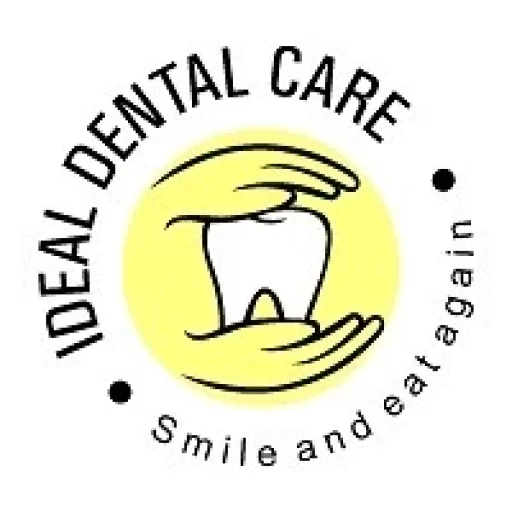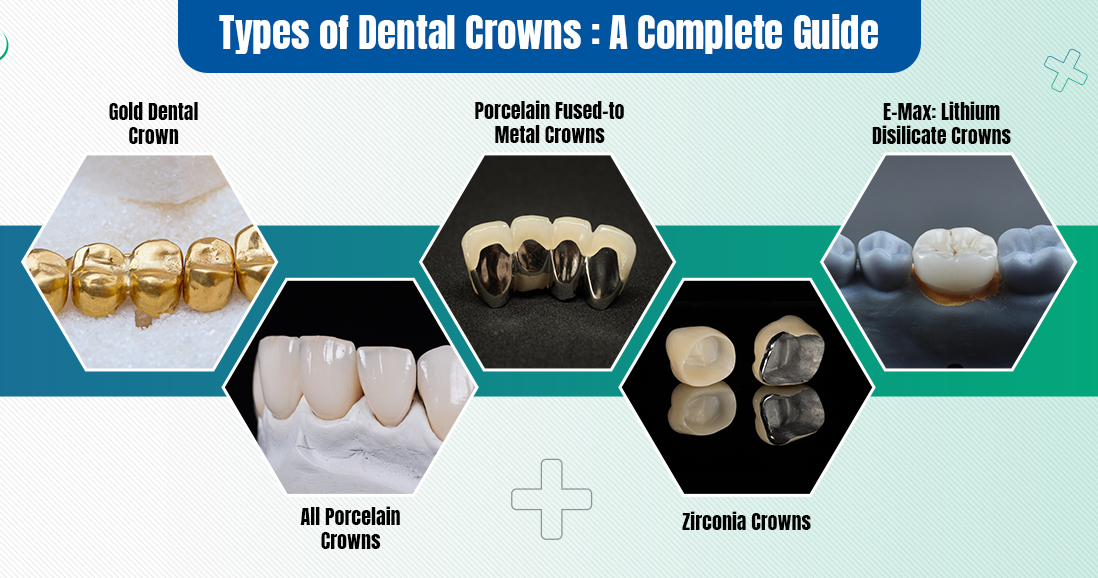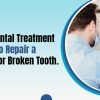TYPES OF DENTAL CROWNS: A COMPLETE GUIDE
Dental Crowns are one of the best methods to preserve a decaying tooth. Dental crowns are coverings that are placed over broken teeth. When teeth fillings fail to remedy the problem, dental crowns are installed to cover and restore the contour of the teeth. Multiple products are used to make dental crowns, such as Metals, porcelain, ceramics, and resins can all be used to make dental crowns. Besides routine good dental hygiene, they usually do not require special maintenance over time.
Dental crowns have long been used to restore the look and function of a decayed tooth. These tooth-shaped caps aid to restore your teeth and enhance your smile.
What are Dental Crowns?
Your teeth might get damaged over time. This can occur for various causes, including tooth decay, traumas, or use over time. Your teeth might change shape or size. Dental crowns are tooth-shaped “caps” that cover your natural tooth. The crown restores the tooth’s shape, size, strength, and look. The dental crown is cemented onto your tooth and covers the visible portion of it.
What are onlays and 3/4 crowns?
Crowns are of wide varieties and can be utilised on your teeth. Onlays and 3/4 crowns are dental crowns that do not cover as much of the underlying tooth as standard dental crowns. A conventional crown will completely encase your tooth. When you still have a strong tooth structure, onlays and 3/4 crowns may be appropriate. Compared to full crown coverage, it is considered a more cautious method. In this operation, your dentist removes the damaged area and reshapes the tooth to get a customised crown for the teeth.
Why do you need dental crowns?
Your dentist may advise you on possible treatments after a complete examination. Some of the most popular reasons for getting a dental crown are:
- Protecting a weak (perhaps decayed) tooth structure Repairing a fractured or severely worn-down tooth
- A massive filling covers and supports a decaying tooth.
- Replacing a missing tooth with a Dental bridge
- Covering up crooked or discoloured teeth.
- Providing coverage for a Dental Implant.
- A tooth is treated with a Root Canal procedure.
What does getting a dental crown involve?
A Dental Crown is something a dentist can only do in a single appointment if the dentist has a CEREC device that allows patients to get the crown in one visit. In case of choosing a crown that is custom made from a Dental Lab that may take 2 visits. However, CEREC technology makes it easier for your dentist to complete the crowning procedure in a single visit.
The procedure may also differ depending on the type of dental crown. In general, obtaining a crown entails the following:
- The dentist will prepare your tooth for the fabrication of the crown afterremoving the decay or doing a root canal, or both.
- They make a Impression of your tooth so that the crown fits perfectly.
- A temporary restoration protects the tooth while the crown is ready. To keep this temporary cap from cracking, take extra care of it and avoid eating hard or sticky foods.
- Your dentist will have the crown prepared to cement to the teeth
Types of Dental Crowns
Crowns come in various styles according to materials, cost, processes, and the patient’s needs. The following are the most common types of crowns used in dentistry:
- Gold: Gold dental crowns are made of copper and other metals like nickel or chromium. The real benefit of gold crowns is their longevity and strength. Some dentists may recommend a gold tooth for back restorations, depending on the needs of each patient. However, gold crowns are no longer famous because of their colour tone and appearance.
Gold crowns are sturdy and resistant with a long lifespan (if properly maintained). They are perfect for posterior restorations, particularly second molars. However, They do not resemble natural teeth. They do wear down slowly like natural enamel. Moreover, Some people may be affected by gold alloy crowns and experience side effects such as allergic reactions or swelling.
- All Porcelain Crowns: One of the most common types of crown used presently is wholly constructed of porcelain. All porcelain crowns are made of porcelain or ceramic that looks likeable and absolutely natural. They are the same shape, size, and colour as your natural teeth. They are biocompatible; they contain no toxic metals and are highly recommended for front tooth restorations.
- Porcelain Fused-to-Metal Crowns: Another popular form of dental crown is porcelain-fused-to-metal (PFM) crowns. They offer both strength (due to their metal construction) and beauty (due to the porcelain coat). They are attractive and long-lasting and have been in business for almost 50 years. They’re highly effective and are less expensive than all-porcelain crowns combined.
However, due to the metal in these crowns, there may be a grey line at the gum line. This may not provide the 100% aesthetically pleasing appearance that all-porcelain crowns offer; this type of crown may also wear down more easily against opposing teeth in people who clench their teeth.
- Zirconia Crowns: Zirconium is a novel substance that combines metal strength with the aesthetics of porcelain crowns. Highly durable, attractive, and long-lasting (fewer possibilities of chipping or breaking), zirconia can be shaped in the same dental office, resulting in less time to complete the procedure. High translucent zirconia and stacked zirconia crowns have recently become more trendy.
Zirconia crowns are less likely to wear down. They are biocompatible as they are metal-free and unlikely to cause allergic reactions. However, Adjusting solid zirconia can be tricky, and their strength can cause the opposing teeth to wear out quickly.
- E-Max: Lithium Disilicate Crowns: The most recent type of crown in dentistry is known as E -Max. It is a lithium disilicate-based all-ceramic crown (which is also light and thin). They have excellent aesthetics and can be very strong and long-lasting. They are a perfect choice for both front and back teeth.
However, They could be expensive, particularly for dentists. Some dentists have observed issues utilising E-Max for posterior teeth, mainly when performing multiple units.s




